T31 Series Repair Instructions
Repair Instructions for Mechanical Seal/"O" Ring Kits, Basic Repair Kits, and Major Rebuild Kits
See the full O&M Manual for further detais.
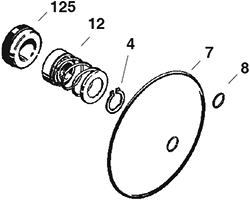 |
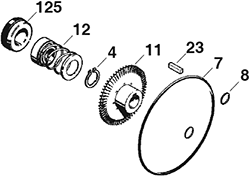 |
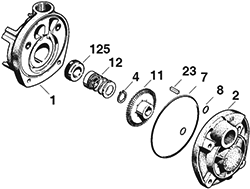 |
Mechanical Seal/"O" Ring Kit |
Basic Repair Kit |
Major Rebuild Kits |
PUMP ENDS
A. Preliminary
B. Disassembly
C. Inspection of Components
D. Reassembly
E. Testing and Final Adjustments
5A Preliminary
Before attempting any service on the pump or motor, disconnect the electrical power to the pump motor. If the pump and motor are to be removed as a unit, note the wiring configuration. Use colored or numbered tape to mark the wire connections of the motor and power source, for reconnection. If the pump is being used to pump hot liquid, let the pump and liquid cool before starting disassembly.
-
Disconnect the inlet and outlet piping before unbolting the pump and motor. If the pipes are corroded, use penetrating oil on the threads to aid in removal.
-
Unbolt the motor from the base and remove the unit. All work on the unit should be performed on an elevated workbench whenever possible.
5B Disassembly
The following tools and equipment are needed for disassembly of T31 Series Pumps.
-
Soft plastic or wooden mallet
-
Small ball pein hammer
-
10mm wrench or socket
-
Snap ring pliers
-
Penetrating oil
-
11/16” wood dowel (Approx. 6” long.)
-
Thin blade screwdriver
-
Cealube G or similar glycol base lubricant (DO NOT use petroleum products.)
To disassemble the pump:
Refer to Figure 5-2 for reference to the numbered parts in the procedures below.
-
Remove all liquid from the pump. Air blown through the pump will remove the water quickly.
-
Remove the four (4) M6-1 X 80mm bolts (#19) from the cover (#2).
-
Remove the cover. In some cases light tapping with a plastic or wooden mallet on the outside diameter of the cover may be required to loosen it from the motor bracket. Care should be taken if a screwdriver is needed to pry between the cover and motor bracket. Damage to the “O” ring (#7) and/or impeller (#11) can result.
-
Remove the impeller. This is easily done by setting the motor on end. The impeller is a slip fit and under normal conditions, can be removed by hand or by gently tapping on the end of the shaft with a mallet. Striking the shaft too hard could damage the seat, rotating element, or the motor. After removing the impeller, the impeller key (#23) needs to be removed from the shaft keyway.
-
Remove the snap ring (#4) from the shaft; note the spring that is held in place by the snap ring. Remove the spring from the shaft.
-
To remove the rotating element (#12), gently slide the motor bracket (#1) forward on the shaft to move the rotating element high enough to be removed by hand. Using tools on the rotating element may damage the rotating element or the seat. Take precautions to keep the rotating element clean if it is to be reused.
-
Next, remove the motor bracket.
-
To remove the seat (#125). Refer to Figure 5-1. Place the motor bracket face down on a clean flat surface. Look into the opening in the center of the motor bracket, and you will see a portion of the seat. Insert the 11/16” dowel and, very gently, tap the seat until it drops out. Care must be taken with the seat. It is often a brittle material and is prone to breakage. It is recommended that a new replacement seat be installed during reassembly.
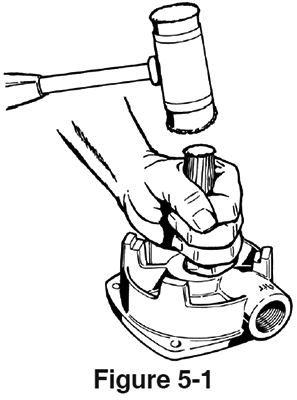
5C Inspection of Components
Thoroughly clean all parts. All components should be examined for wear and corrosion. Replace any parts that show visible wear. If the pump was not producing sufficient pressure or capacity, the clearances between the motor bracket, cover and impeller probably exceed the maximum allowable clearance. At minimum the impeller should be replaced in this case. If the total side running clearance for an impeller exceeds .007”, it is unlikely that pump performance will reach that of a new pump except at lower discharge pressures.
The “O” rings and other elastomeric components should be replaced if they have been deformed or cut.
If seal components must be reused, carefully inspect for microscopic cracks and nicks. Scratches that might be ignored elsewhere can produce leakage if they are on seal carbons and seat wearing surfaces.
Cleanliness is imperative when working with mechanical seals. Almost unnoticeable particles between seal faces can be, and often are, the cause of early seal failures.
Check the impeller; it is designed to float. It should move easily on the shaft. As long as it can be moved on the shaft by hand, it is loose enough. If the impeller can be rocked or wobbled, it is too loose and must be replaced.
Check the shaft for galling, pitting, and corrosion. If the shaft is corroded where the seal comes in contact with the shaft, the motor or bearing pedestal shaft must be replaced. Surface corrosion must be removed so that seals can slide freely during assembly. The shaft diameter should be no smaller than .002” below the nominal fractional seal sizes. Remove any nicks or burrs which may have occurred during disassembly. Reclean parts as necessary.
5D Reassembly
All parts should be visually inspected and cleaned or replaced as outlined in 5C above.
-
The seal seat (#125) must be installed in the motor bracket (#1) before the bracket is installed on the motor. To install the seat:
a. Place the motor bracket face up on a flat surface.
b. Apply a coating of compatible lubricant to the elastomer portion of the seat to aid with installation.
c. Carefully press the seat, smooth side up, into the seat cavity of the motor bracket. Thumb pressure is usually sufficient to install the seat. -
Installing the motor bracket. This is best done with the motor standing on end. Make sure that both the “C”-face of the motor and the feet of the motor bracket are clean. Slide the motor bracket over the shaft onto the motor.
-
Installing the rotating element (#12). Lubricate the I.D. of the rotating element. Place the rotating element on the shaft with the carbon end towards the seat. Place the spring over the shaft, with the backing plate up, and compress the spring to locate the rotating element against the seat. If this fails to seat the rotating element gently push the rotating element down with a thin blade screwdriver being careful not to damage the seat or the rotating element.
-
Compress and hold the seal spring slightly below the snap ring groove and install the snap ring (#4). Make sure the snap ring is locked in the groove.
-
Install the impeller key (#23) into the shaft keyway.
-
The impeller is a slip fit and should slide on firmly but easily until it stops against the impeller wearing surface. Force should not be required or used to install the impeller in the correct position. The impeller hub should be facing out away from the motor bracket. Refer to Figure 5-2.
-
Next, rotate the impeller by hand; the impeller should move freely.
-
Place the large “O” ring (#7) into the outside “O” ring groove in the motor bracket. Place the two (2) smaller “O” rings (#8) into the smaller “O” ring grooves.
-
Place the cover (#2) over the motor bracket and install the four (4) M6-1 X 80mm bolts (#19). Tighten the bolts systematically, alternating diagonally across the cover. DO NOT exceed 7-11 ft. lbs. of torque or damage to the motor “C”-face may occur.
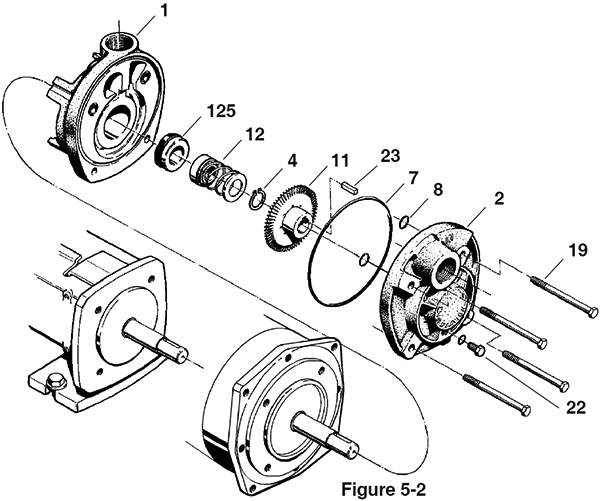
5E Testing and Final Adjustment
The pump is now ready for installation. Final adjustments will be made with the pump in operation.
-
Connect all piping and fill the pump with fluid.
-
Reconnect the electrical connections, referring to the colored or numbered tape used to mark the wires.
-
Make sure all valves are opened, and fluid will flow through the system.
-
Start the pump and make the final adjustments to the M6 bolts holding the cover on. These bolts must be torqued to about 7-11 ft. lbs. to obtain proper performance.
-
Check for leaks on pump and piping. Special attention should be given to the seal area at the rear opening in the motor bracket.
-
Under pressure, the impeller will find its “hydraulic” balance.
-
Using an amprobe or similar device, check for motor overload.
-
While the impeller is seating, it is common to experience some variance in readings. After a run-in period the readings should level off.
This completes the adjustment and testing phase. The pump is ready for service.
|
Download a printable version of the T31 Repair Instructions in .pdf format.
If you do not have the Adobe Acrobat Reader, click
here  to download the most
recent version from Adobe.
to download the most
recent version from Adobe.

